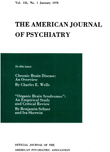OCCUPATIONAL REHABILITATION OF PSYCHIATRIC CASES
Abstract
1. A brief historical review of the modern machinery for the rehabilitation and resettlement of psychiatric disabled persons in the United Kingdom is described.
2. The present investigation was designed to discover the fate of psychoneurotic patients who had been referred to the D. R. O. for placement and thereby to determine the efficacy of the joint work carried out by Roffey Park Rehabilitation Centre and the D. R. O. service.
3. The method of investigation consisted of the follow-up by D. R. O. s of 115 consecutive cases about 2 years after hospitalization; 15 were untraceable. A social worker then interviewed 97 of these patients; of the 3 remaining, 2 were in mental hospitals and 1 was untraceable.
4. A description of the sample at the time of admission to Roffey Park is included.
5. The results of the follow-up are enumerated. There appears to be little change in the ratio of employed to unemployed, but there is an apparent increase in the proportion of skilled workers.
6. Thirty-eight patients had improved in health, 43 were unimproved, and 18 were worse than on admission to Roffey Park.
7. Thirty-four patients were living satisfactorily at home, 37 had fairly satisfactory homes, and 26 were living unsatisfactorily.
8. Twenty-one patients were recommended for Government Training Courses. Five gave up before the end; of the 16 completing training only 10 were working in their training trades. The disturbing effect of delay in starting training is stressed.
9. The results are discussed and compared with those of other investigations.
10. A plea is made for further research to discover whether the expenditure on the Government Training Scheme is justified and to improve the present methods of selection of trainees.
Access content
To read the fulltext, please use one of the options below to sign in or purchase access.- Personal login
- Institutional Login
- Sign in via OpenAthens
- Register for access
-
Please login/register if you wish to pair your device and check access availability.
Not a subscriber?
PsychiatryOnline subscription options offer access to the DSM-5 library, books, journals, CME, and patient resources. This all-in-one virtual library provides psychiatrists and mental health professionals with key resources for diagnosis, treatment, research, and professional development.
Need more help? PsychiatryOnline Customer Service may be reached by emailing [email protected] or by calling 800-368-5777 (in the U.S.) or 703-907-7322 (outside the U.S.).



